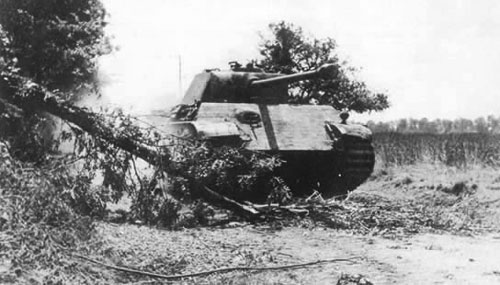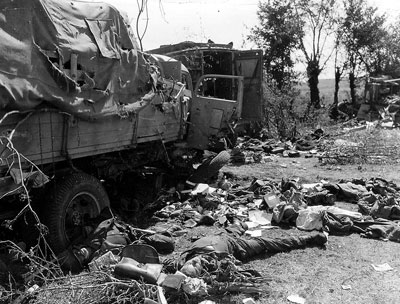with Steve Bernich
D-Day: German offers Flames Of War players all they need to field any of the Heer Panzer Division of Normandy. This article has everything you’d want to know before sinking your teeth into one of these colourful and storied unit miniature form.
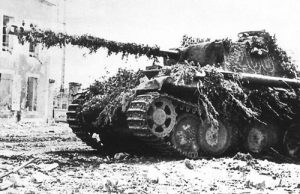
Key to Hitler’s strategy of pushing the “little fish back into the pond” was the ability of the Panzer divisions to halt the Allied offensive at the beachhead. However, because of the Fuhrer’s own belief that a larger invasion was imminent at Pas de Calais, several key Panzer divisions were held from the Normandy campaign until it was too late while Generalfeldmarschall Rommel had to make do with only four divisions under his command.
Many of the panzer divisions that would see action in the two months of the Normandy campaign were Waffen SS and not necessarily under the command of the standard Heer army generals. However, the 2., 9. and 116. Heer Panzer divisions would all see action in northern France alongside the 21. and 130. Panzer Lehr Panzer divisions.
Playing the 2., 9. or 116. Panzer divisions in Flames Of War can be done with the D-Day: German book and Command Cards.

The 2. Panzerdivision was already a veteran force by 1944, having fought in almost every theatre up to that point including Poland in 1939, Western France in 1940, the Balkans in 1941, the Eastern Front from 1941 to 1943 before being transferred to the West in 1944. The experience paid off as its Allied opponents considered it an equal to the Waffen SS divisions. However, that experience would not be able to save the 2. Panzerdivision from the onslaught that shook Northern France in the summer of 1944.

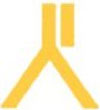
The rest of the Panzerwaffe would be held under Hitler’s direct command, to counterattack a possible second invasion site.
However, Rommel’s control would still not be enough to get the 2. Panzerdivision into position until 13 June. The division was forced to detour approximately 160 miles through the French countryside due to bridges destroyed by Allied air strikes and Allied air superiority, which made panzers moving during the day the equivalent of a suicide mission. Lead elements supported Panzer Lehr and SS Schwere Panzerabteilung 101 in the attack on Villers-Bocage. Several of the 2. Panzerdivision’s tanks were lost, but the village was recovered from the British 7th Armoured Division under the onslaught of the three tank forces coming from its north, south and east sides. That evening, elements of the 2. Panzerdivision were used at a gap in the German lines near Caumont, with preparations to launch an attack the following morning. However, the attack was never launched as a bombardment of Allied air, artillery and naval guns opened on their start positions. Oberfeldwebel Hans Erich Braun, with the 38.
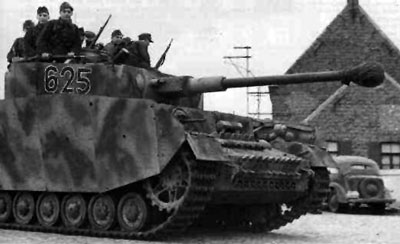
After being stymied at Caumont, the rest of the division finally caught up to its forward positions a week later. The 2. Panzerdivision was finally able to form a coherent fighting force. For the rest of June, the 2. Panzerdivision operated in and around Caumont. The Panther battalion was detached to help stop the British Operation Epsom. Division reports indicate that the Panthers alone were responsible for 53 destroyed British tanks and 15 anti-tank weapons in a single day.
In the third week of July, the 352. Infanteriedivision relieved 2. Panzerdivision, but the rest was short lived. Strength reports indicate it was rated “Kampfwert I”, which indicates the ability to take on any offensive mission. Operation Cobra began on 25 July and the tanks of the 2. Panzerdivision were too valuable to let sit idle while the Americans broke through the German lines. On 28 July Fieldmarschall Guenther Hans von Kluge ordered the 2. Panzerdivision into action against the Americans from its position near Caen. Crossing the Vire River, the 2. Panzerdivision took a position at Tessy-sur-Vire, flanking the American breakout. They helped stop the US XIX Corps near Troisgots, but soon had to withdraw because of the threat of envelopment by American infantry.
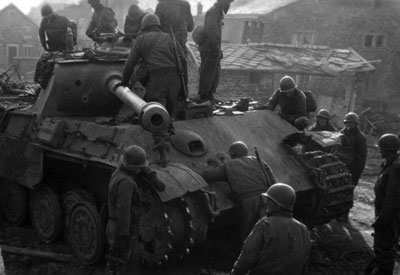
The original jump off date was 6 August, but due to too many of the units involved not being ready, Kluge delayed for 24 hours. Kluge would receive the harshest of criticism for not starting the operation on time, but the fact was that any mass of German armoured divisions was likely to attract Allied air power, which hampered the movement of tanks to their start points.
Despite of delays, the attack was launched on a foggy morning on 7 August. The fog allowed 2. Panzerdivision to penetrate 7 miles into Allied lines before being stopped by Combat Command B of the US 3rd Armored division. The Panther battalion had reached St. Barthelemy, just north of Mortain, an American strongpoint. As the Panzer V tanks inched through the village, the American ambush began a stretch of intense fighting. The Panthers did not retreat, Luttwitz was determined to bludgeon his way through the town. In spite of the anti-tank guns and bazookas arrayed before the Panther battalion, they reached the other side of St. Bathelemy two intense hours later. Advancing out into clear terrain, it was not long before a flight of approximately 20 Typhoon fighter-bombers spied the concentration of German armour and pounced, sending them back into the relative safety of the village. American counterattacks were vicious and strong, and by 9 August, 2. Panzerdivision found itself back at its start positions.
With the failure of Operation Luttich, it became quite clear to most German forces in Normandy that the best plan of action was to retreat to the east, away from the encircling American, British and Canadian armies. In fact, by the second week of August, the Allies were working to encircle the German 7th Army in and around Falaise, birthplace of William the Conqueror. Many rear echelon units of the panzer divisions were already streaming east with whatever they could carry.
In fact, many vehicles of all types, including armoured fighting vehicles were being abandoned on the roadways. The risk was simply too great that a moving German vehicle would be attacked by the Allied air forces.
The 2. Panzerdivision was no different in this regard and after being forced back past Mortain, the division did an about face and attempted to breakout from Falaise and then to the Seine River where a new defence could be mounted. From 14 August on, elements of the 2. Panzerdivision would try to get to the small village of St. Lambert where the last remaining bridge over the Dives River still stood. The Dives was small as far as rivers go, but a bridge would enable some of the armoured vehicles to cross expediently without fear of bogging in the thick mud. The bottleneck at the bridge would be a site of horrible carnage that many soldiers on both sides would soon wish to forget.
By 21 August, the 2. Panzerdivision had in fact escaped from the Falaise pocket with little more than an infantry battalion left. It didn’t have a single surviving tank.
After Falaise, the division was once again went through a period of refitting and rest and would see action during the Wacht Am Rhein (Watch on the Rhein) offensive in December of 1944 where it suffered heavy losses. Near the end of World War II, the 2. Panzerdivision fought in the Mosel region and later in Fulda as part of the Thuringen Panzer Brigade before finally surrendering to American forces in May 1945.
Order of Battle – 2. Panzerdivision
Commanding Officer Heinrich von Luttwitz
2. Panzergrenadier Regiment
Panzergrenadier Bataillon I
Panzergrenadier Bataillon II
304. Panzergrenadier Regiment
Panzergrenadier Bataillon I
Panzergrenadier Bataillon II
3. Panzer Regiment
Panzer Abteilung I
Panzer Abteilung II
74. Artillerie Regiment
Panzer Artillerie Abteilung I
Panzer Artillerie Abteilung II
Panzer Artillerie Abteilung III
2. Panzer Aufklarungs Abteilung
273. Heeres Flak Abteilung
38. Panzerjager Abteilung
38. Panzer Pionier Bataillon
38. Panzer Nachrichten Abteilung
38. Divisional Support Units
9. Panzerdivision



The 9. Panzerdivision was another veteran division of various theatres before the Normandy Invasion. The 9. Panzerdivision saw action in the Western Campaign, notably in Belgium in 1940, the Balkans in 1941 for a brief period of time.
They then spent 1941 through early 1944 on the Eastern Front in various engagements including Kursk and the River Dnieper where it suffered heavy losses. Finally, the 9. Panzerdivision was transferred to northern France for rest and refitting in April of 1944 where it absorbed the 155. Panzer Reserve Division to get back to full strength.
The division would not be ready for action during the Cobra breakout by American Armored divisions, but it would be used to try and halt the advance shortly before the general collapse and attempts to escape through Falaise. Without its Panther battalion, the 9. Panzerdivision was set to oppose the advance of the Allied XV Corps composed of the U.S. 5th Armored Division and the French 2nd Armored Division. Unfortunately, the 9. Panzerdivision barely slowed the American offensive due to it being committed in bits and pieces as units arrived at their start points, as opposed to in one cohesive counterattack. With their backs against the Alecon supply dumps, there was little to fall back to. In fact, after a series of intense tank battles from 10 to 12 August, the supply dump itself was little more than an empty inferno. The division itself found itself surrounded and unable to fight, having lost approximately 100 panzers.
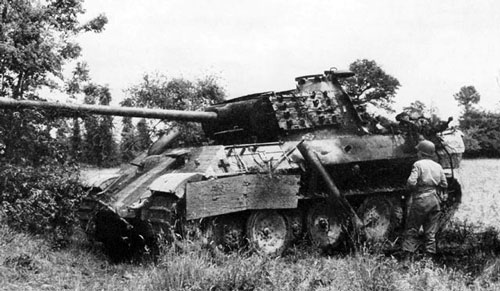
Order of Battle – 9. Panzerdivision
-Commanding Officer Oberst Max Sperling
33. Panzer Regiment
Panzer Bataillon I
10. Panzergrenadier Regiment
Panzergrenadier Bataillon I (half-track)
Panzergrenadier Bataillon II (motorized)
11. Panzergrenadier Regiment
Panzergrenadier Bataillon I (motorized)
Panzergrenadier Bataillon II (motorized)
50. Panzerjager Abteillung
9. Panzer Aufklarungs Abteilung
76. Panzer Artillerie Regiment
86. Panzer Pionier Bataillon
287. Heeres Flak Abteilung
116. Panzerdivision – Greyhound Division

Initially assigned to Generalfeldmarschal Erwin Rommel’s Armee Group “B”, it had the ability to respond without Hitler’s authorization when the invasion occurred, unlike many of the other panzer divisions in the region. It was considered veteran due to the 16. Panzergrenadierdivision’s experience on the Soviet front and was rated as “Kampfwert I”, indicating it was ready for any and all duties.
The Greyhounds did not join the battle for Normandy until late in July. They were still conducting training exercises and were held in reserve should a British breakthrough at Caen occur. When the Americans captured St. Lo they were called up and sent into action on 28 July in the Vire River area. Heinz Guther Guderian, the 116. Panzerdivision Operations Officer and son of the famous tank commander, would later write that “fate did not smile on the 116. Panzerdivision” when describing the action of 29 July. A panzer battalion commander was immediately killed on their advance towards the American lines, halting the panzer columns and sending the supporting panzergrenadiers into hiding in the surrounding woods. Allied fighter-bombers pinned them down and force them to hold position, as breaking cover would invite further attacks. By 30 July, they saw heavy fighting against VII Corps, preventing the US 2nd Armored Division from advancing past Villebaudon and Percy. However, the combination of the Jabos (jagerbomber, American fighter bombers) and stiff resistance on the ground stopped the 116. Panzerdivision from getting further than they did the day before.
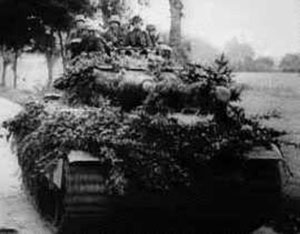
Rumour has it that Von Schwerin then circulated a note to his troops telling them privately that they should head east at the earliest opportunity and attempt to escape from the pocket that was forming around Falaise.
Heading east fitted into high command’s plans. There was an attempt to have Panzer Group Eberbach, then comprised of parts of 1. SS-Panzer, 2. Panzer and 116. Panzer divisions, to stop Patton’s drive on Avranches. The plans for the attack were changed to a drive north in an attempt to stop the spearhead of US 5th Armored and French 2nd Armored divisions, hopefully destroying both. The attack was held until 14 August in Argentan when cooler heads prevailed. Perhaps it was the fact that the three panzer divisions could muster only 70 tanks between them convinced the German generals that it was time to head east out of the Falaise area.
Generalfeldmarschall Guenther Hans von Kluge, Army Group B commander asked for permission to withdraw on 16 August, got no response from OKW, so he then ordered a fighting withdraw of all units at 2pm on that same day. Hitler finally responded two hours later with the same idea, but added that 2. SS-Panzer and 116. Panzer divisions should strike forward in an attempt to widen the German exit for more German troops to escape in the hopeful confusion. The attempt was somewhat successful with the US 90th Infantry Division’s roadblocks at Le Bourg-St. Leonard being the primary target. The American riflemen controlled a ridge that had views of several of the escape routes just to the north of their position. The 90th was pushed off, but counterattacked and reclaimed the ridge that evening.
The next 24 hours saw intense fighting for control of the area, culminating in the US troops taking it permanently. After that attack, the men of the 116. Panzerdivision joined the general chaos of the attempts to escape the Falaise pocket.
By 21 August, the Greyhound division only had 12 functioning tanks when they reached the north bank of the Seine River, where they had begun less than a month earlier. In September 1944 the 116. Panzerdivision as the only unit garrisoning Aachen when the attack by US 3rd Armored Division began. Having little time to rest, the 116. Panzerdivision also saw action in Dusseldorf and most famously in the Battle of Hurtgen Forest in November. December saw them attacking near St. Vith as part of the Ardennes offensive and in February 1945 they defended the Roer River against First Canadian Army and British XXX Corps. They saw another month of aggressive defensive combat against the Allies and surrender when hostilities in the Ruhr pocket ceased in April 1945.
Order of Battle – 116. Panzerdivision
-Commanding Officer – Generaleutnant Graf von Schwerin
60. Panzergrenadier Regiment
Panzergrenadier Bataillon I
Panzergrenadier Bataillon II
156. Panzergrenadier Regiment
Panzergrenadier Bataillon I
Panzergrenadier Bataillon II
16. Panzer Regiment
Panzer Abteilung I
Panzer Abteilung II
146. Panzer Artillerie Regiment
Panzer Artillerie Regiment I
Panzer Artillerie Regiment II
Panzer Artillerie Regiment III
116. Panzer Aufklarungs Abteilung
281. Heeres Flak Artillerie Abteilung
228. Panzerjager Abteilung
675. Panzer Pionier Bataillon
228. Panzer Nachrichten Abteilung
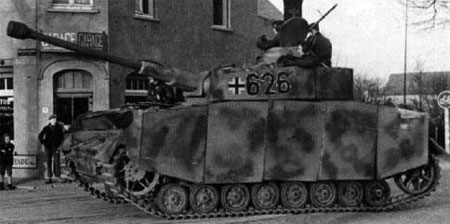
By the time the Falaise Gap was closed, several divisions, including Panzer Lehr, 2. Panzer, and the 10. SS-Panzer divisions had no tanks at all and the five remaining divisions (9., 116., 21., 12. SS, 2. SS) had only about 60 tanks between them.” (Zaloga, pg. 89)

